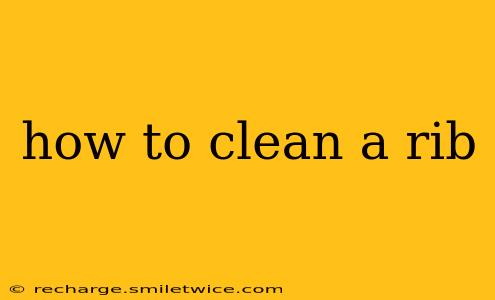Cleaning ribs properly is crucial for achieving tender, flavorful results. Whether you're working with spare ribs, baby back ribs, or St. Louis-style ribs, the process involves several key steps to remove unwanted membranes and excess fat. This guide will walk you through the process, answering common questions along the way.
What tools do I need to clean ribs?
You'll need just a few simple tools to effectively clean your ribs:
- A sharp knife: A boning knife or a sturdy kitchen knife works best. You need something that can easily slice through the membrane and fat without tearing the meat.
- Paper towels: These are essential for wiping away excess fat and cleaning the surface of the ribs.
- Running water: This will be needed to rinse the ribs after cleaning.
- Optional: Meat cleaver or butcher's knife: For removing the rib tips (if desired).
How do I remove the membrane from ribs?
The membrane, a thin, tough layer on the back of the ribs, needs to be removed to ensure tender ribs. Here's how:
- Locate the membrane: Flip the rack of ribs over so you're looking at the bony side. The membrane is a thin, silvery-white sheet on the back.
- Loosen an edge: Use the tip of your knife to gently lift a corner of the membrane.
- Grab and peel: Once you've got a small edge loose, use your fingers or a paper towel to grab onto it and peel it away from the ribs. It should come off in one fairly large piece. If it tears, that's okay; just continue peeling away the remaining sections.
Why is removing the membrane important? The membrane acts as a barrier, preventing the marinade or sauce from penetrating the meat and resulting in tough, chewy ribs. Removing it allows for better flavor absorption and more tender results.
How do I trim excess fat from ribs?
While some fat is desirable for flavor and moisture, excess fat should be trimmed. Too much fat can render the ribs greasy and less appealing.
- Inspect the ribs: Look for areas with thick layers of fat.
- Trim carefully: Use your knife to carefully trim away excess fat. Don't go overboard; a thin layer of fat is beneficial. Aim for about 1/4 inch of fat remaining.
- Discard the fat: Dispose of the trimmed fat.
What about trimming rib tips?
Rib tips are the meaty ends of the ribs. Some people prefer to remove them and cook them separately, while others leave them attached. If you choose to remove them, use a meat cleaver or butcher's knife to carefully separate them from the main rack.
How do I clean ribs after butchering?
After removing the membrane and trimming excess fat, rinse the ribs thoroughly under cold running water. Pat them dry with paper towels before proceeding with your chosen cooking method. This ensures the ribs are clean and ready for seasoning and cooking.
Should I soak ribs before cleaning?
Soaking ribs before cleaning isn't necessary. Removing the membrane and trimming the fat is best done when the ribs are relatively dry, providing better grip and control.
How do I know if my ribs are clean enough?
Your ribs are sufficiently clean when the membrane is completely removed, excess fat is trimmed, and the surface is rinsed and patted dry. The ribs should appear relatively clean and free of any large pieces of fat or membrane.
By following these steps, you can ensure your ribs are properly cleaned and ready to be cooked to perfection, resulting in delicious and tender results. Remember to always prioritize safety when handling knives.
